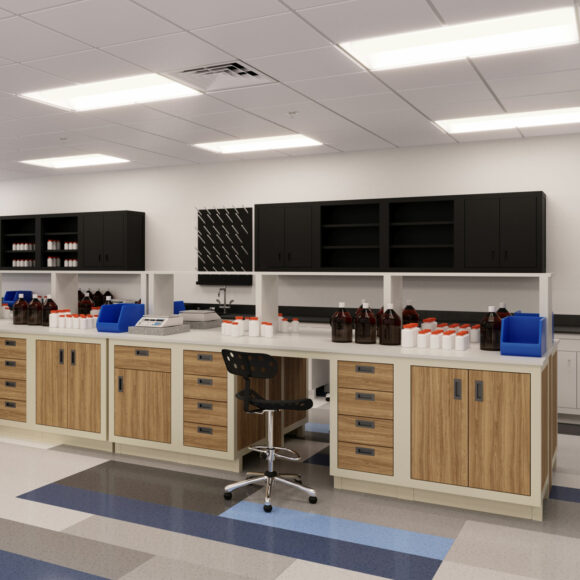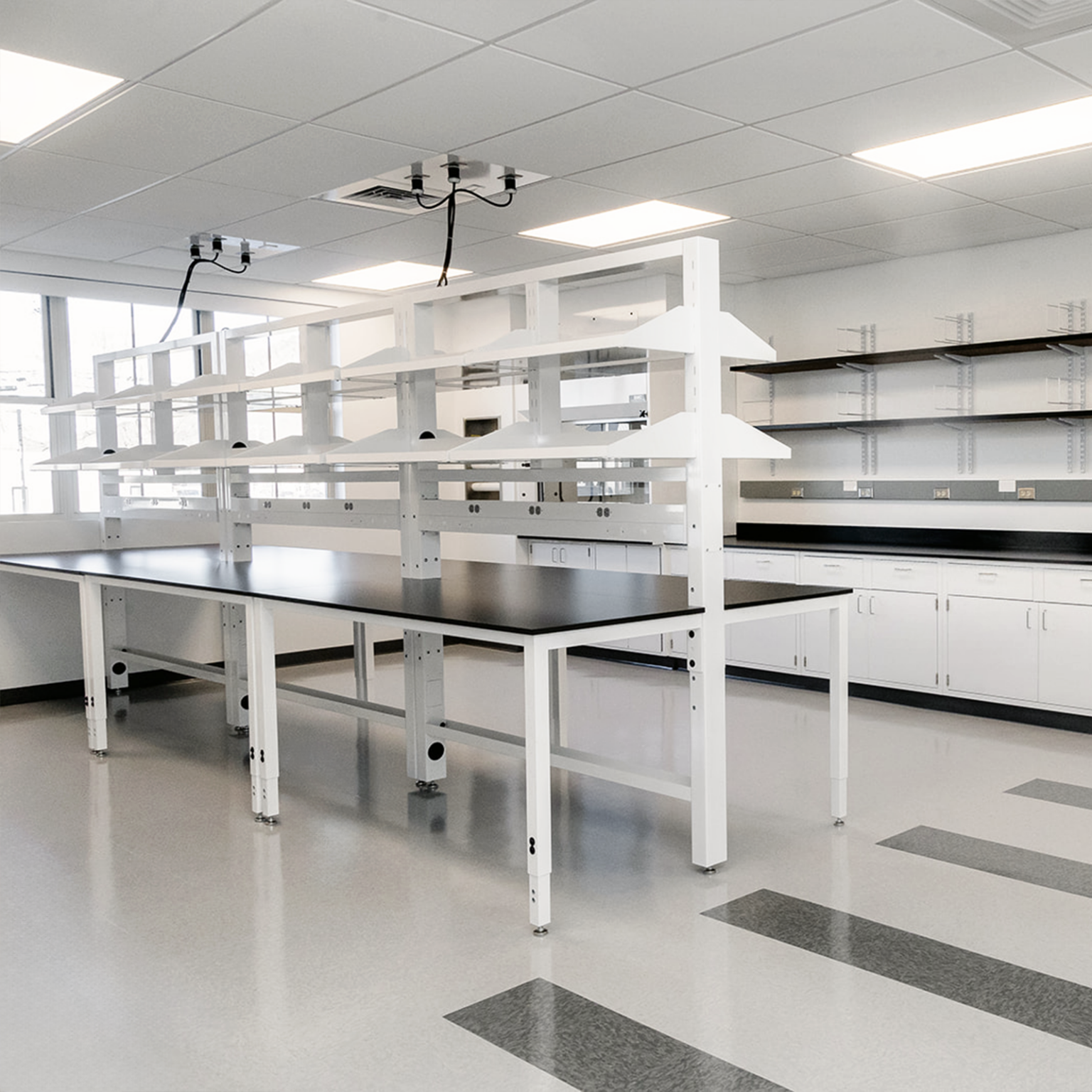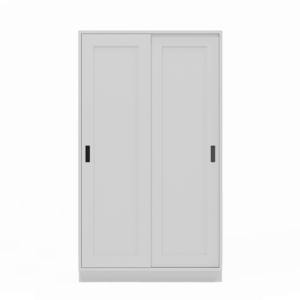Solutions to Meet the Changing Needs of Today’s Healthcare and Laboratory Furniture Installations
Specifying the right kind of furniture for healthcare and laboratory installations is more complicated than ever, thanks to today’s challenging healthcare and laboratory environments.
Lab managers, architects and designers, space planners, and furniture professionals are facing a challenging and diverse set of requirements – here are just a few of which that may be on your project requirement list:
- Doing more with less, e.g. getting more functionality out of each square foot.
- Accommodating unconventional sites, e.g. converting retail, office, or warehouse facilities into healthcare and laboratory settings.
- Finding ways to future-proof healthcare and laboratory installations, e.g. making it possible to change facility layouts as requirements evolve.
- Designing modern shared open laboratory and healthcare spaces that allow expensive equipment resources and space allocation across a larger number of teams than before.
- Creating more inviting laboratory spaces (useful for talent acquisition) that seamlessly integrate with adjoining office areas – a change from the legacy approach of segregating lab spaces away in less accessible areas, such as basements.
- Finding ways to reduce costs, shorten lead times, and speed up onsite installation times.

What are the Most Appropriate Applications for Traditional Millwork, Fixed Casework, Modular Casework, and Modular Workbenches in Different Healthcare and Laboratory Installation Scenarios?
When specifying furniture for laboratory and healthcare facilities, today’s clients have a wide range of furniture choices to choose from, including traditional millwork, fixed casework, modular casework, and modular workbenches.
This abundance of choices can be confusing for end-user clients who may not be familiar with what makes the most sense in meeting their unique needs.
Let’s look at each of these four different types of healthcare and laboratory furniture categories and identify the most appropriate applications for each one.
· Appropriate Applications for Traditional Millwork

Traditional millwork can be a preferred choice, especially when matching existing legacy installations – such as restoring historically significant interiors or creating sensitive additions that mimic the look and feel of traditional laboratory installations – or choosing to create a statement architectural design element.
Because each millwork installation is individually designed, this choice requires more coordination and development time to create the necessary detailed architectural drawings needed to define each component before they can be commissioned for milling at the factory and sent to the installation site for final construction.
As a result, traditional millwork may be the most appropriate when its inherently higher cost and longer lead and installation times are not a primary concern.
In other words, the individual “piece construction” method of building traditional millwork can put significant pressure on project budgets, lead times, and installation schedules.
Careful thought must also be given to maintenance issues in all wood construction. While many traditional millwork laboratory designs feature the classic look of clear wood finishes, maintaining these wood surfaces over time in “as new” condition may require expensive periodic refinishing.
Accidental damage, such as nicks or spills (whether due to ordinary beverages – or worse, chemical agents), is a valid concern with many traditional wood millwork installations.
Many of these millwork installations rely on either wood or laminate work surfaces, which are less resistant to the type of chemical spills that are common in healthcare settings. (Traditional casework, modular casework, and modular furniture are typically specified with chemical-resistant work surfaces, such as epoxy, phenolic resin, or stainless steel.)
If an accidental spill is not successfully treated right away, it may leave permanent marks on the wood or laminate millwork surfaces that can be expensive to repair and may require sourcing new matching pieces.
Also, traditional wood millwork furniture may be subject to warpage or cracking in laboratory and healthcare environments unless the humidity is tightly controlled, which may become an issue during evenings or weekends when HVAC systems automatically engage energy-saving modes.
· Appropriate Applications for Traditional Casework

Traditional casework is a popular choice for clients who desire a traditional look and feel but are looking for a consistent, predictable, high-quality product available at a significantly lower cost than millwork.
Today’s casework installations typically use factory-built cabinetry components that are assembled on-site. This approach provides a high level of quality and consistency while still providing a traditional look.
Casework can be specified in a variety of materials to meet your needs.
For example, metal cabinetry casework (such as stainless steel or powder-coated steel) with glass cabinet glazing is an ideal choice in sanitary healthcare, laboratory, and cleanroom environments where it can provide years of service with minimal wear, even when exposed to heavy use or harsh chemicals.
Metal casework also coordinates well visually with specialized functional cabinetry (such as chemical storage cabinets) or metal fume hoods for an integrated look and feel.
Traditional metal casework installed along interior walls also coordinates well with modern steel modular workbenches positioned in the interior of the room, creating a cohesive visual environment.
Disadvantages of Fixed Casework
Fixed casework is less flexible in meeting future needs. Once installed, it’s difficult and costly to reconfigure, which can be an issue in healthcare settings where technology and usage needs change over time.
Also, if a section becomes damaged, it’s harder to repair, and matching replacements may not be available. It’s also more expensive upfront than modular furniture due to the increased time required for design, build, and installation.
· Appropriate Applications for Modern Modular Casework (RGX)

Modern modular casework is the newest choice in healthcare and laboratory installations – pioneered by Formaspace and its industry-leading RGX line of casework modules.
As the name implies, modular casework is built from individual components at the factory and then shipped directly to the client in flat packs. This approach significantly reduces lead and shipping times as well as costs.
Once on site, the components can be assembled into large linear casework elements that can be leveled and mounted directly to the wall.
This approach provides the “look and feel” of traditional casework at a significantly reduced cost and is proving to be a very popular new option.
Clients also appreciate the fact that the modular casework components can be disassembled and moved (if necessary) or swapped out for different components (such as a casework cabinet with a built-in wet sink) if necessary.
This approach helps address the requirement to “future-proof” healthcare and laboratory installations – by providing the means to easily change and update existing installations as needs evolve down the road.
Modular casework is also attractive to landlords who are converting non-conventional spaces into laboratory and healthcare environments, thanks to its overall higher ROI and faster project turnaround compared to traditional millwork or casework.
· Appropriate Applications for Modular Workbenches

In recent years, modular workbenches have become the “go-to” solution for modern healthcare and laboratory installations. Thanks to the inherent durability and flexibility of modular workbenches, you’ll find heavy-duty powder-coated steel workbenches at state-of-the-art facilities such as the Chan Zuckerberg Biohub or at Roche DNA clinical testing laboratories, to name just a few.
Modular workbenches are highly flexible, making them an ideal solution for open laboratories that provide shared resources among teams. When mounted on heavy-duty casters, individual workbenches can also be moved into position to meet current project needs and then repositioned to meet the requirements of future work.
Modular workbenches also coordinate well with any type of wall-mounted millwork or casework installation.
When it Comes to Project Requirements, What are Some of the Key Pros and Cons When Choosing between Traditional Millwork, Fixed Casework, Modular Casework, and Modular Workbenches?
What are the pros and cons of choosing between traditional millwork, fixed casework, modular casework, and modular workbenches?
Let’s look at several typical project requirements and identify which options make the most sense for your application.
| Requirement | Traditional Millwork |
Traditional Casework |
Modular Casework (RGX) |
Modular Workbenches |
| Overall Project Cost | D | C | B | A |
| Modular workbenches offer the best project cost value, followed by modular casework (RGX). Traditional casework and traditional millwork are significantly more expensive. | ||||
| Manufacturing and Shipping Lead Times | D | C | A | A |
| Thanks to standardized components and flat-pack shipping, modular casework (RGX) and modular workbenches have significantly quicker lead and shipping times. | ||||
| Installation Times | D | B | A | A |
| Modular casework (RGX) and modular workbenches can be installed quickly on site. Traditional casework requires more time, and the individual piecework of millwork is the slowest to install. | ||||
| Durability | B | A | A | A |
| Modular casework (RGX), modular workbenches, and traditional casework are available in long-lasting powder-coated steel frames and cabinetry and can be specified with durable, chemical-resistant worksurfaces, including phenolic resin, stainless steel, and epoxy. Wood millwork tends to be less durable in healthcare and laboratory settings. | ||||
| Customization Options | A | A | A | A |
| All four categories can be extensively customized with different storage, shelving, and layout options. | ||||
| Historical Appropriateness | A | B | B | C |
| For historical renovation projects originally crafted in traditional woodwork, millwork may be the most appropriate choice for renovation projects or sensitive additions that need to match the original design intent. Traditional and modular casework (RGX) can also mimic the look and feel of older installations, making them a suitable replacement in many instances. | ||||
| Sustainability and LEED Credits |
D | C | A | A |
| Modular casework (RGX) and modular furniture can easily be repurposed and moved to new locations as required (possibly earning LEED Credits for sustainability). Traditional millwork is difficult to repurpose. | ||||
| Chemical Resistance | D | A | A | A |
| Depending on the material selection, traditional metal casework, modular casework, and modular workbenches can provide superior resistance to chemical exposure. | ||||
| Sanitary Hygiene, Cleanrooms | D | A | A | A |
| Specifying metal cabinetry and appropriate worksurfaces (such as stainless steel, phenolic resin, or epoxy) for traditional metal casework, modular casework, and modular workbenches can provide superior sanitary hygiene (including in cleanroom applications) compared to traditional wood millwork. | ||||
| Unconventional Space Conversions | D | C | A | A |
| Landlords undertaking the conversion of unconventional spaces into spec laboratories or healthcare facilities find that modular casework and modular workbenches offer the fastest lead/installation times and provide the best overall ROI. | ||||
| Equipment Integration | C | A | A | A |
| Modular furniture (casework and workbenches) and traditional casework can be integrated with lab and clinical testing equipment at the factory before shipping to the site, avoiding costly errors. | ||||
| Chemical Storage | D | A | A | A |
| Factory-manufactured safety cabinets for chemical storage can be integrated with traditional casework, modular casework, and modular workbenches. | ||||
| Safety Equipment Integration |
C | A | A | A |
| Safety equipment, from fume hoods, to snorkels, to glass storage, to emergency eyewash stations and showers, can be designed, integrated, and tested at the factory before installing in the field. | ||||
| Future Proofing | D | C | A | A |
| Modular workbenches (followed by modular casework) offer the greatest flexibility for repositioning and repurposing a major capital expenditure as your future laboratory and healthcare needs change in the future. | ||||
| Tax and Lease Implications | D | D | A | A |
| Talk to your tax attorney about the potential tax saving and depreciation options available for moveable modular furniture installations. If you are leasing space, modular furniture may also avoid categorization as a “leaseholder improvement” (unlike fixed millwork and traditional casework), potentially offering additional flexibility for taking the furniture with you at the end of your lease period. (Check with your real estate attorney/advisor to confirm). | ||||

Your Formaspace Sales Representative or Strategic Dealer Partner Can Help You Decide Which Approach is Right for Your Next New Construction or Facility Remodeling Project

Evolving Workspaces. It’s in our DNA.
Talk to your Formaspace Sales Representative or Strategic Dealer Partner today to learn more about how we can work together to make your next construction project or remodel a success.











